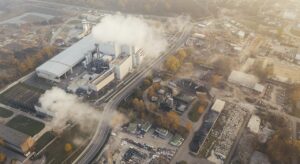The share of wind power in the total generation volume is an important characteristic of the power system. This indicator is neither standardized nor limited. It depends on many features of a particular power grid: existing generating facilities, pricing mechanisms, energy storage capacity, demand management, and other factors. Typically, power grids have their own backup generation and transmission capacity used to ensure trouble-free operation in case of emergencies. These reserve capacities can also serve to compensate for fluctuations in energy generated by wind farms. Studies have shown that the optimal share of wind power is 20%. These studies were conducted for areas with geographically dispersed wind farms, with the ability to control capacity (e.g., hydroelectric power plants) and a developed transmission network that allows for the redistribution of power when necessary. When the share of 20% is exceeded, technical difficulties arise, but even more significant are the economic costs of modernization. It is worth noting that the impact of large-scale implementation of wind power plants on the stability and profitability of the energy system is currently being studied.
To achieve the share of wind power at 100% it is necessary to have a large amount of energy storage or to connect with other energy systems that have their own storage. On short time intervals (month, week, day, hour or less) wind can provide up to 100% of current consumption, and the excess energy must be stored or exported. Industry can take advantage of strong wind, for example, at night when the amount of power output exceeds demand. This applies to industries such as silicon, aluminum, steel, or natural gas and hydrogen. All of these will achieve a substitution rate of 100 percent
Fluctuations in generated power
As mentioned above, the instantaneous power generated by a wind turbine is not constant and can fluctuate rapidly and significantly. Fluctuations in annual averages also exist, but they are not as significant. Power fluctuations can cause an imbalance between electricity production and consumption, which limits the share of wind power in the energy system. The intermittent and uncontrollable nature of wind power generation leads to negative consequences, including increased costs for power conversion, the need to maintain significant backup power sources, the complexity of the control system, etc.
The power produced by a wind generator fluctuates and must be replaced by other energy sources when the airflow is weak. Modern power systems are able to cope with emergency outages of generating capacity, as well as with daily fluctuations in consumption. At the same time, traditional power plants are able to deliver maximum power during 95% of the operating time. The same cannot be said for wind power plants.
Currently, power systems with a large number of wind farms require frequent activation of backup natural gas-fired generating capacity to maintain a stable power supply when conditions are not favorable for wind power generation. With a lower share of wind farms, power fluctuations are not a big problem. However, even with a 16% share on windy days, wind power can outperform all other sources of electricity in the country in terms of power generation.
Combining intermittent renewables with stable non-renewables helps create a sustainable energy system that provides a reliable supply of electricity to consumers. The increase in the share of renewable energy sources has been successful in the real world.
HAWP installations
If we do an all-cost analysis, wind power installations (High-Altitude Wind Power) could be the cheapest source of energy. Only hydropower plants and conventional wind turbines used to power local consumers can compete with them.
HAWP installations operate at high altitudes. We are not talking about tens of meters, where conventional wind turbines can do just fine. HAWP technologies involve flying installations at altitudes where the wind energy is much greater than at the ground surface.
Several research groups are developing Airborne Wind Energy (AWE) technologies for use up to 2,000 feet (609.6 m). In addition, there are also developers creating solutions that work at altitudes above 2,000 feet. The 2,000-foot altitude was chosen to meet the requirements of the U.S. Federal Aviation Administration. This organization considers objects at this altitude to be unsafe for conventional aviation.


